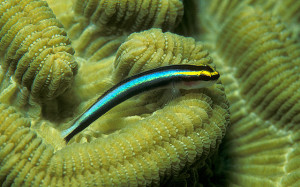by Joe Dawson, science writing intern
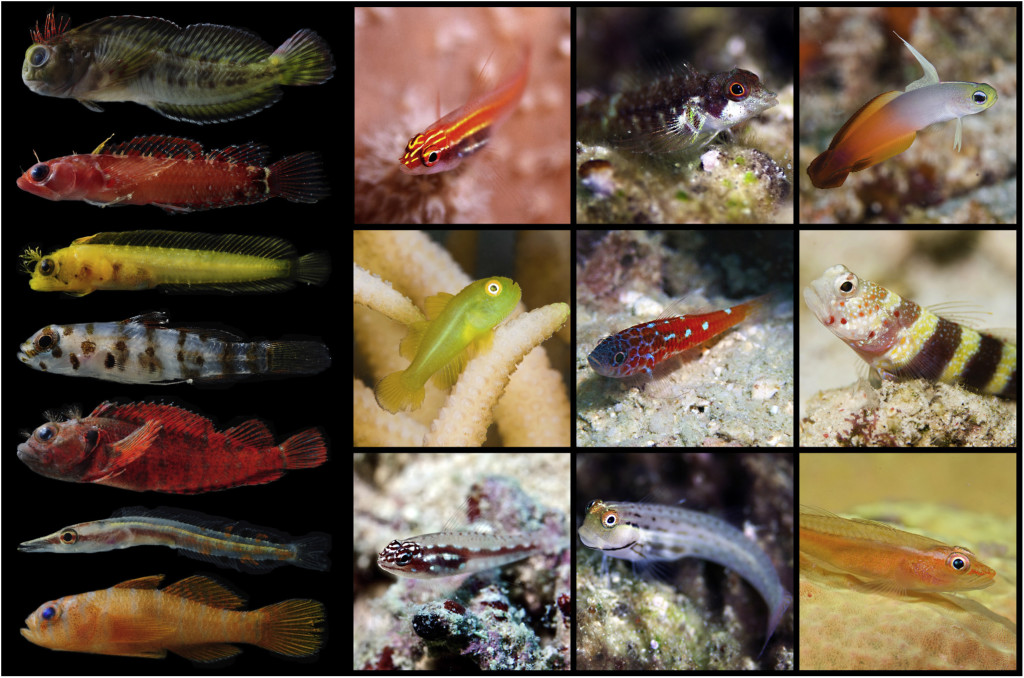
A sample of the diversity present within the cryptobenthic reef fishes. Figure from Goatley and Brandl 2017.
Go snorkeling on a coral reef, and you’ll have a hard time not being impressed by the abundance and variety of the fish there. But the fish most divers see make up less than half of the number (and less than half the species) of fish on the reef. Cryptobenthic reef fishes comprise the other half. These fish are small, usually less than 2 inches in length, and hide in coral habitats, either by appearance or by their behavior. Even scientists have been slow to start searching for them, but cryptobenthics are turning up in about every reef habitat where scientists have bothered to look! In the June 5 issue of Current Biology, SERC Scientist Simon Brandl and colleague Christopher Goatley of the University of New England published a quick guide to cryptobenthic reef fishes. Brandl thinks that these little fishes deserve more recognition, and we agree! Therefore, we’re happy to present these honorees with the following awards.
Coolest Camo
Runners Up: Frogfishes (Family Antennariidae), Scorpionfishes (Family Scorpaenidae)

The painted frogfish, Antennarius pictus (Credit: John E. Randall/Hawaii Biological Survey, used under CC BY-NC 3.0)
Weird and tricky, frogfishes have plump, short bodies. They’re often covered in spines or even hair-like appendages and prefer to stay still, waiting and blending in, for prey to swim close enough that they can gulp them. The deep-sea dwelling anglerfish is one famous member of this group.
Scorpionfish are also sit-and-wait predators, using their feathery scales or skin flaps to look like rocks or coral, then pouncing on nearby prey. The most renowned member of this group is the lionfish.
Winner: The Paleback Goby (Gobulus myersi)

The paleback goby, Gobulus myersi (Credit: Simon Brandl/SERC).
Picture a great white shark. This sleek predator has an instantly recognizable color pattern—dark gray on top with a white belly. This pattern of coloration is common in fish, and it works as camouflage for most. Seen from above, a great white blends in with the dark water. From below, its white belly helps it blend in with the lighter-colored surface. The paleback goby, however, reverses the standard trend. It is nearly white on top, and dark below. Why? Because it lives its life buried in the sand, presumably foraging for small crustaceans. From the top, it looks just like the sand!
Cooperation Award
Runners Up: Cleanerfish Gobies (Various Species in Genera Gobiosoma and Elacatinus), Coral Gobies (Genera Gobiodon)
Try tipping your stylist like this at your next appointment: “There are some gobies in the Caribbean that clean larger fishes (such as the sharknose goby Elacatinus evelynae), thus gaining food in exchange for grooming services,” says Brandl.How about a new fad diet? “It seems like some of the coral gobies actually feed on coral mucous, which is a pretty nutritious but relatively uncommon resource to use.” Other gobies clean toxic algae off corals, helping the corals, and incorporate the toxins as a defense against predators.
Winner: Shrimp Gobies (e.g. Genera Amblyeleotris, Cryptocentrus)
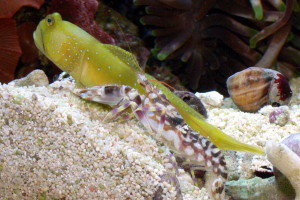
The yellow shrimp goby Cryptocentrus cinctus and its near-constant companion, the snapping shrimp Alpheus bellulus (Credit: Wikimedia user Haplochromis, used under CC BY-SA 3.0)
“The shrimp gobies are certainly the most spectacular symbioses we know of in the crypto world,” says Brandl. This group of fishes lives in close association with shrimp. The shrimp dig and maintain a burrow for both fish and shrimp to live in, and the fish serve as guard dogs, watching at the opening of the burrow for predators that might eat the shrimp or themselves.
“New research has just shown that the shrimp actually feed on the goby feces as well, adding another dimension to the relationship,” says Brandl. Best friends!
Best Innovation in Mating
Runners Up: Seahorses (Genus Hippocampus), Pipefishes (Subfamily Syngnathinae)
Seahorses and pipefishes are rather famous for the males breeding eggs in their pouch until the young fishes hatch. The male and female seahorse court for days, often with tails entwined, until the female deposits her eggs in the male egg pouch. The male holds the eggs for a period of weeks, then mates again within hours of birth.
Winner: Cardinalfishes (Family Apogonidae)
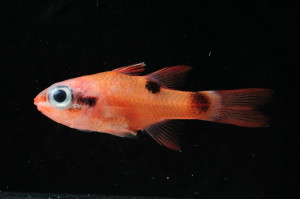
The Atlantic cardinalfish Apogon maculatus (Credit: Simon Brandl/SERC).
Cardinalfish do something even more out of the ordinary: “In cardinalfishes (family Apogonidae), males breed the eggs in their mouths until they hatch, having evolved particularly large mouths for that purpose,” says Brandl. But do they even get a card on Father’s Day? Of course not.
Sneakiest
Runner Up: Tube Blennies (Genus Acanthemblemaria)
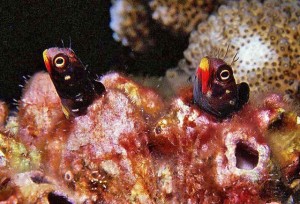
Two Revillagigedo barnacle blennies, Acanthemblemaria mangognatha, peeking out of their tubes (Credit: D. Ross Robertson/STRI)
These gopher-impersonating fish spend almost their entire lives in small tubes built by worms or other invertebrates, only darting out of their tubes to snatch a piece of plankton drifting by.
Winner: The Stargazers (Family Dactyloscopidae)

Dactyloscopus boehlkei, Boehlke’s sand-stargazer (Credit: Jeff Williams/National Museum of Natural History)
The stargazer hangs out near coral outcrops in the fine sand, half buried with only its eyes sticking out, waiting for a clueless little crustacean to float by. It eats, then buries itself again for the next bite.
Most Stylish Fish Award
Runners Up: Emblemaria Blennies (Genus Emblemaria), Pike Blennies (members of Family Chaenopsidae), and the Mandarin Dragonet (Synchiropus splendidus)
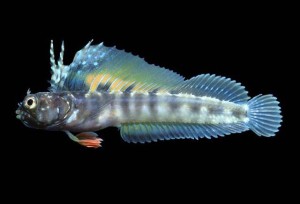
The sailfin signal blenny, Emblemaria piratica (credit: Gerald R. Allen via Shorefishes of the Eastern Pacific).
For our final award we have some seriously stylish swimmers. She can’t mate with you if she doesn’t notice you first, and the elaborate courtship rituals and spectacular features of Emblemaria blennies and pike blennies, and the vivid coloration of fishes like the mandarin dragonet, are all aimed at making males as attractive as possible to the opposite sex.

Mandarin dragonet, Synchiropus splendidus (Credit: Luc Viatour / www.Lucnix.be).
Winner: Tube Blennies (Genus Acanthemblemaria)

The roughhead blenny, Acanthemblemaria aspera, complete with head tassel. (Credit: Simon Brandl/SERC)
When it comes to style, these tube-dwelling swimmers bring home the glory. One of the coolest features about them is their extravagant “hairdos”, which (presumably) are sensory organs that help them perceive the world around them, although the exact purpose is not completely known. Called “cirri,” these can be absolutely ridiculous in species like the roughhead blenny.

